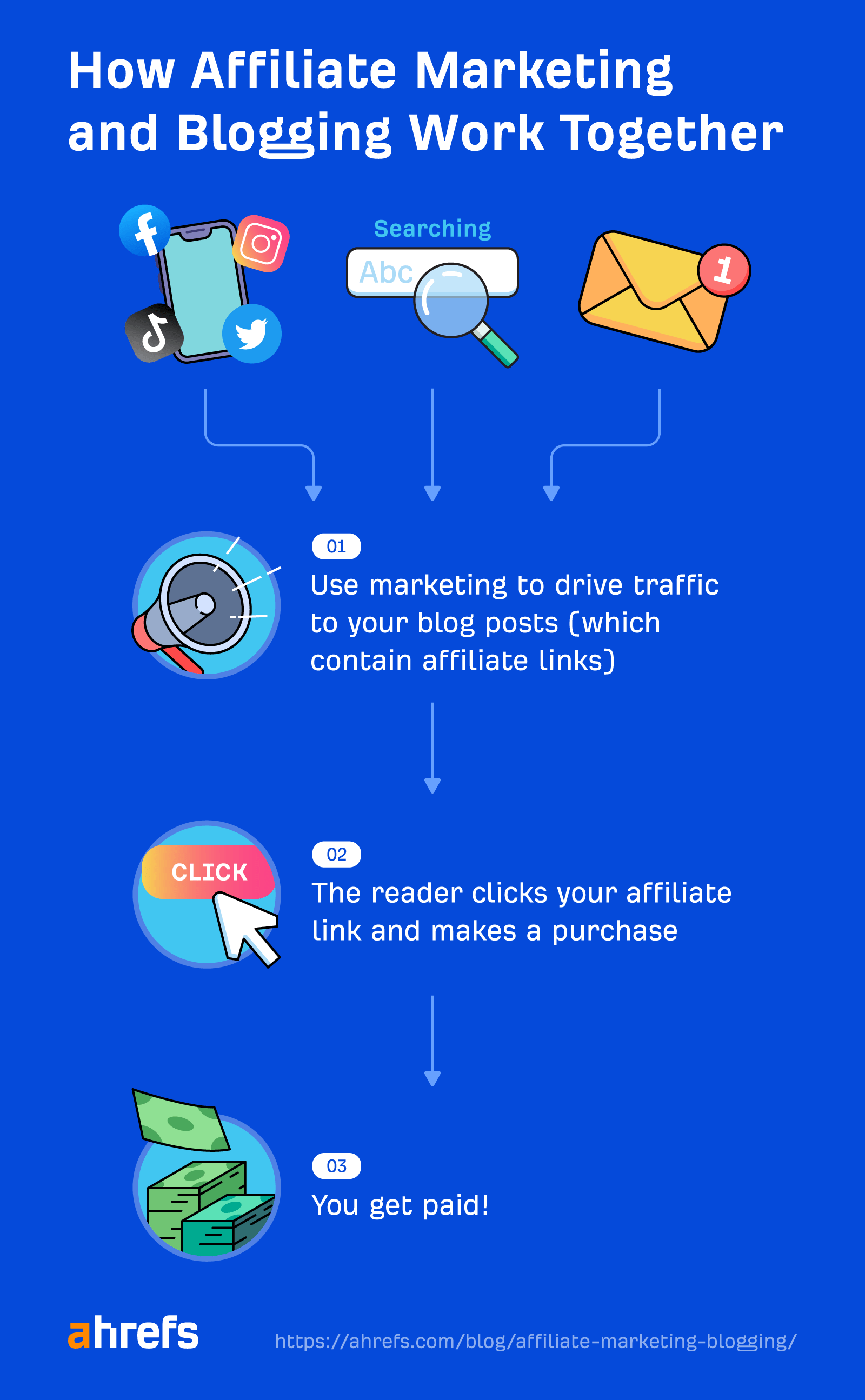Affiliate marketing and blogging go together like cookies and milk—they’re made for each other.
I’ve been monetizing my blogs with affiliate marketing for over 10 years and even recently sold one of my affiliate-monetized blogs for multiple six figures. It can be a lucrative combination.
In this article, I share everything I know about how to earn a serious income by merging affiliate marketing and blogging.
We looked at how much affiliate marketers make and found that, on average, affiliate marketing bloggers make between $30,000–$50,000 per year.
That said, it’s possible to make much more than this. Some high-ticket affiliate marketers earn several million per year. It depends on how much time and effort you put into your business and what niche you’re in.
Most high-earning bloggers use a combination of search engine optimization, social media, and email lists to drive traffic to their blog posts, which contain affiliate links.
Once a user lands on the blog, they may click on one of the affiliate links and purchase the product that’s recommended, resulting in the blogger being paid a commission by the affiliated brand.

Affiliate marketing and blogging work so well together because:
- Low overhead – You don’t have to hold inventory, pay for storage, or hire people to pack, ship, or manage products. You just need website hosting and a desire to write.
- No customer service – Your affiliates handle all the returns and customer questions. You don’t need to provide customer support beyond helping people decide if they should purchase the product or not.
- Passive income – Especially with SEO, you can get traffic to your blog whether you’re working or relaxing on the beach. It’s a great way to make a passive income.
You can find affiliate programs in many ways:
You can also find affiliate programs by searching “[niche] affiliate programs” on Google and looking at the listicles others have written about your niche.
For example, “coffee affiliate programs” brings up several articles:

Once you’ve decided on your niche and found some good affiliate programs, you need to decide what topics make the most sense to cover on your blog.
Luckily, there are a few tactics that make this really easy.
Study competitors to find what’s working for them
The first and often easiest tactic is to spy on your competitors’ content. You can see what affiliate programs they’re a part of and how they promote those affiliates just by browsing their websites.
For example, coffee affiliate Homegrounds displays its top affiliate products right at the top of its page in the navigation:

And if you want to see exactly which keywords it’s ranking for on Google and how much traffic it’s getting from those keywords, you just have to plug the website into Ahrefs’ Site Explorer and go to the Organic keywords report.

As you can see, this brought up a lot of keywords—104,603 to be exact. Luckily, you can filter this down to show only the most relevant keywords.
Personally, I like to target keywords with a KD (Keyword Difficulty) score of less than 30 and a volume of at least 500—guaranteeing you only see keywords with decent traffic potential that aren’t too difficult to rank for.

This whittled down the list to 3,360 keywords. That’s still a lot, but it’s much more manageable. You can filter it down further if you like, but I personally like to just start looking to see what came back from this first filter.
Peruse the list of keywords and check the URLs that rank for keywords you like to see how they’re promoting their affiliates. Add any promising keywords to your content calendar.
For example, you can write about the best “coffee roasters” and promote them using affiliate links, just like Homegrounds does.

Do some basic keyword research
Keyword research is the starting point of any good SEO strategy.
Ahrefs has a free keyword generator tool you can use to make this process super easy.
Simply type in a broad keyword related to your niche, like “coffee” or “coffee maker,” and you’ll be shown keyword ideas:

Then, use these ideas to come up with blog topics. For example, you can write a review of the “bunn coffee maker” or a roundup showcasing the “best coffee makers.”
If you want additional ideas or more keyword data, Ahrefs also has Keywords Explorer, which provides a lot more info for you to work with.
Here are some other tools to make blogging and affiliate marketing easier:
WordPress
If your website isn’t already built, I highly suggest starting a WordPress website for your blog. It’s free to use, open source, and has all the functionality an affiliate marketer needs.
While you’re at it, check out this list of the best WordPress plugins.
Lasso
Lasso is an awesome tool that helps you manage your affiliate links and add affiliate product display boxes that are clean and conversion-optimized.
They look like this (but can be customized):

Another thing I love about Lasso is that it gives you suggestions of affiliate programs to join for websites that you’re already linking to on your blog.

Ahrefs
Ahrefs is one of my most used tools as an affiliate marketer. I use it to do keyword research, competitive analysis, link building, SEO audits on my websites, and more.
One of my most used features on Ahrefs is the Content Gap tool. You can use it to see all the keywords your competitors rank for on Google that you don’t, which makes coming up with content ideas super easy.

Google Docs and Wordable
I write all of my content for my websites—and for Ahrefs—in Google Docs. It’s super easy to write, edit, and collaborate on content within Google Docs.
The one issue I have with Google Docs is uploading content from the document to WordPress. Unfortunately, it adds unnecessary hidden code to your writing that gets moved over to WordPress when you copy-paste the content.
That’s where Wordable comes in.
Wordable moves documents from Google Docs to WordPress—including uploading images, title tags, alt text, and formatting—at the click of a button. It has saved me countless hours.
Snagit and Loom
Snagit is a screen-capturing tool that allows you to edit your screenshots quickly and easily, then add them to your Google Docs.

Loom is a screen recording tool that lets you record your screen, audio, and (if you want to) video from your webcam.
Loom is great for recording videos for employees and standard operating procedures or for enhancing your how-to content to show your readers how to do whatever it is you’re explaining in text within your articles.
There’s a lot that goes into building a website, starting a blog, and making money from affiliate links. I can’t cover everything in a single article, but I will point you in the right direction.
Here’s an overview of some things you’ll need to know to be successful at affiliate marketing and blogging:
Search engine optimization basics
I already mentioned how well SEO and affiliate marketing go together.
SEO takes time to kick in (we found that it typically takes between three to six months to show results). But once it does, you are rewarded with consistent, recurring monthly traffic sent straight to your affiliate links—i.e., passive income.
For example, BankMyCell is an affiliate blog that gets over 200,000 visits from Google every month.

So what do you need to do in order to rank higher on Google? Three things:
- Find the keywords people are searching for
- Create high-quality content that matches the search intent of those keywords
- Build links to that content from other websites
Of course, there’s more to SEO than these three things. But if you don’t get the basics right, the other stuff doesn’t matter. Check out our complete guide to SEO to learn more.
Social media marketing
While SEO takes a lot of time to work, social media can give you results much faster. But it requires near-daily effort to continue to perform—if you stop posting, traffic stops coming.
That said, social media is an important part of a good marketing strategy.
For example, Making Sense of Cents is one of the biggest financial blogs out there. Michelle Schroeder-Gardner, the owner, is an expert at affiliate marketing. She does a great job on social media:
- ~137,000 Facebook followers
- ~20,000 Twitter followers
- ~34,000 Instagram followers
- ~175,000 Pinterest followers

All that, in addition to over 20,000 monthly visitors from organic search, makes for a highly successful affiliate marketing blog.
How can it be done? Well, you can get inspiration from one of the blog’s contributors, who wrote a step-by-step guide on how she achieved so much success on Pinterest. You can read it here.
It boils down to:
- Finding your niche.
- Figuring out what kind of content people want and creating that content.
- Sharing click-worthy photos and graphics.
That’s how things are done on Pinterest, and it’s pretty much the same requirements for other social media platforms. Basically, find your niche, share what people care about, and make your content click-worthy and engaging.
Email list building
The third organic marketing strategy that pairs well with affiliate blogging is an email newsletter.
Making Sense of Cents also has over 300,000 email subscribers, and this is actually where it makes the majority of its affiliate income.

How is it done? Here are some things I noticed about Michelle’s blog and email strategy:
1. She offers content upgrades on each of her blog posts, e.g., ebooks, spreadsheets, and printable PDFs in exchange for an email.

2. She has an email opt-in at the top of her homepage.
3. She promotes her online community via Facebook and gets people to subscribe to her newsletter through that community.
Check out this guide to learn more about how you can grow an email list on your blog.
Finally, here are some frequently asked questions and answers around affiliate marketing:
How do I start an affiliate marketing blog?
To start an affiliate marketing blog, I recommend you read our guide to affiliate marketing and our guide on how to use WordPress. You can use these guides to set up your blog in a single weekend with enough ambition.
How much can a beginner affiliate make?
Beginner affiliates can earn up to $10,000 per year pretty quickly. (One study found that more than half of all affiliate marketers earn less than $10,000 annually.)
However, it depends on your niche and your skills as an affiliate marketer. On a personal note, I was able to earn a few hundred dollars per month within six months of starting my affiliate marketing journey.
Is it hard to make money as an affiliate?
That depends on what you consider “hard.” It can take time to build an audience who trusts you enough to purchase products based on your recommendation, but anyone can do it if they’re willing to learn and be consistent.
Can you start affiliate marketing with no money?
Yes—sort of. You can start affiliate marketing with as little as $36.
How long does it take to make money as an affiliate marketer?
Based on my experience and speaking with many affiliate marketers, on average, it takes around six to 12 months to start earning money as an affiliate marketer and around two years to earn enough money to quit your day job.
It takes time to set up your website, grow an audience, and learn everything you need to know to make money. Of course, the time it takes depends on your dedication and a bit of luck.
Final thoughts
Affiliate marketing and blogging go together like rice and beans. It just makes sense.
While it may take you a year or two to earn decent money from your affiliate partners, this is an online business with very little overhead and high potential for passive income.
Have questions? Ping me on Twitter.
